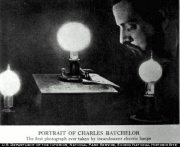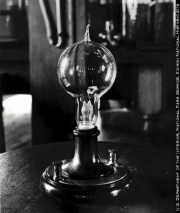Difference between revisions of "Incandescent lamp"
(username removed) |
|||
| Line 2: | Line 2: | ||
== Description == | == Description == | ||
| − | A light produced when an electric current flows through a wire contained in an glass bulb. The resistance of the filament causes it to heat up and glow, thus producing the bright illumination. Thomas Edison made the first commercially viable incandescent bulb in 1879 with a [ | + | A light produced when an electric current flows through a wire contained in an glass bulb. The resistance of the filament causes it to heat up and glow, thus producing the bright illumination. Thomas Edison made the first commercially viable incandescent bulb in 1879 with a [[carbon]] filament in an evacuated glass bulb. [[Tungsten]] filaments were introduced in 1907 and are still used today. They are placed in a glass bulb filled with inert gases, such as [[argon]], to prevent combustion and minimize evaporation of the wire. Tungsten produces a warm yellowish light with a color temperature in the range of 2700-2900 K (standard) or 2900-3100K (low voltage). Incandescent lights have a fairly good color rendering index although they are stronger in the yellow and weaker in the blue regions. They emit little [[ultraviolet radiation|ultraviolet light]], but produce high levels of [[infrared radiation]] (heat). Incandescent lights are energy inefficient and have a short lifespan (750-1000 hours). |
[[File:Incand.lamp_Edison_nps.gov.jpg|thumb|Edison Incandescent Lamp]] | [[File:Incand.lamp_Edison_nps.gov.jpg|thumb|Edison Incandescent Lamp]] | ||
| + | |||
== Synonyms and Related Terms == | == Synonyms and Related Terms == | ||
Revision as of 14:39, 16 January 2014
Description
A light produced when an electric current flows through a wire contained in an glass bulb. The resistance of the filament causes it to heat up and glow, thus producing the bright illumination. Thomas Edison made the first commercially viable incandescent bulb in 1879 with a Carbon filament in an evacuated glass bulb. Tungsten filaments were introduced in 1907 and are still used today. They are placed in a glass bulb filled with inert gases, such as Argon, to prevent combustion and minimize evaporation of the wire. Tungsten produces a warm yellowish light with a color temperature in the range of 2700-2900 K (standard) or 2900-3100K (low voltage). Incandescent lights have a fairly good color rendering index although they are stronger in the yellow and weaker in the blue regions. They emit little ultraviolet light, but produce high levels of Infrared radiation (heat). Incandescent lights are energy inefficient and have a short lifespan (750-1000 hours).
Synonyms and Related Terms
lightbulb; light bulb; incandescent lighting; Glühlampe (Deut.); lampe à incandescence (Fr.); lâmpada incandescente (Port.)
Additional Information
° T.Brill, Light: Its Interaction with Art and Antiquities. Plenum Press, New York, 1980. ° M.Cook, M.Ferro, "Electric Lighting and Wiring in Historic American Buildings" Technology & Conservation, 1/83, p. 28-48.
Authority
- Marjorie Shelley, The Care and Handling of Art Objects, The Metropolitan Museum, New York, 1987
- Dictionary of Building Preservation, Ward Bucher, ed., John Wiley & Sons, Inc., New York City, 1996
- Book and Paper Group, Paper Conservation Catalog, AIC, 1984, 1989
- The American Heritage Dictionary or Encarta, via Microsoft Bookshelf 98, Microsoft Corp., 1998
- Website address 1 Comment: AMOL reCollections Glossary - http://amol.org.au/recollections/7/c/htm

